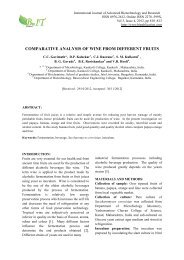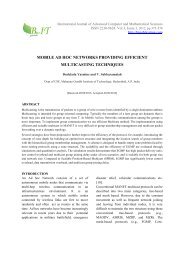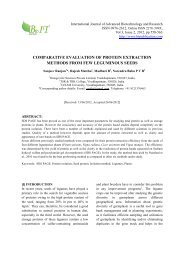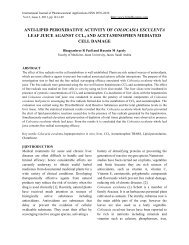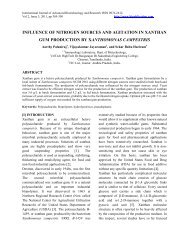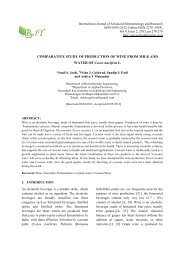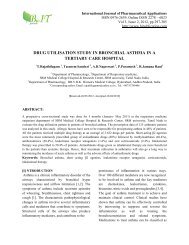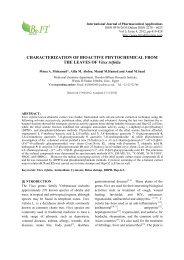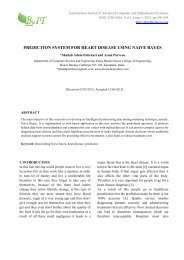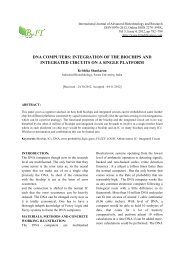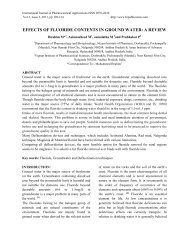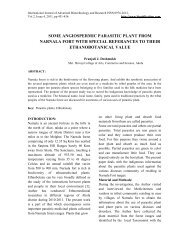KINETICS AND ISOTHERM STUDIES OF MERCURY AND IRON ...
KINETICS AND ISOTHERM STUDIES OF MERCURY AND IRON ...
KINETICS AND ISOTHERM STUDIES OF MERCURY AND IRON ...
You also want an ePaper? Increase the reach of your titles
YUMPU automatically turns print PDFs into web optimized ePapers that Google loves.
International Journal of Chemical Sciences and Applications ISSN 0976-2590.<br />
Vol 1, Issue 2, Dec-2010, pp 50-60 http://www.bipublication.com<br />
<strong>KINETICS</strong> <strong>AND</strong> <strong>ISOTHERM</strong> <strong>STUDIES</strong> <strong>OF</strong> <strong>MERCURY</strong> <strong>AND</strong> <strong>IRON</strong><br />
BIOSORPTION USING SARGASSUM SP.<br />
ABSTRACT<br />
* A.Saravanan 1 , V.Brindha 2 , E.Manivannan 3 and Soundarajan Krishnan 4<br />
1,3 Department of Chemical Engineering,Hindustan University,Padur,Chennai – 103,India.<br />
2 Department of Biotechnology,Hindustan College of Arts & Science,Padur,Chennai – 103,India.<br />
4 Department of Chemical Engineering,Taylors University,Malasiya.<br />
Biosorption is a process in which solids of natural origin are employed for binding heavy metals. It is a promising<br />
alternative method to treat industrial effluents, mainly because of its low cost and high metal binding capacity. In<br />
this work, the mercury and iron biosorption process by Sargassum sp. seaweed biomass was studied. The work<br />
considered the parameters of mercury and iron sorption such as pH, temperature, agitation and biomass size. The<br />
optimal conditions were : pH 4, temperature 30ºc, agitation 100 rpm and biomass size 0.7mg and the maximum<br />
metal uptake was 67.094mg/g, 64.32mg/g, 53.735mg/g, 41.883mg/g respectively for mercury. For iron the pH was<br />
3, temperature 30ºc, agitation 150 rpm, biomass size 0. 3mg and the maximum metal uptake was 16.63mg/g,16.23<br />
mg/g, 24.78mg/g and 14.62mg/g. The mercury and iron uptake was also quantitatively evaluated using adsorption<br />
isotherms. Results indicated that for iron, Langmuir model gave a better fit and for mercury Freundlich gave a<br />
better fit to the experimental data in comparison with the other isotherm models. Kinetic models such as pseudo first<br />
order and pseudo second order was also evaluated. The adsorption process follows pseudo second order kinetics for<br />
both the metals.<br />
KEYWORDS : Biosorption, Mercury, Iron, Kinetics, Adsorption isotherm, Sargassum.<br />
INTRODUCTION<br />
Heavy metals released into the environment by<br />
technological activities tend to persist<br />
indefinitely, circulating and eventually<br />
accumulating throughout the food chain,<br />
becoming a serious threat to the environment.<br />
Biosorption is proven to be quite effective at<br />
removing metal ions from contaminated solution<br />
in a low cost & environment friendly manner.<br />
The major advantages of biosorption over<br />
conventional treatment methods include low cost,<br />
high efficiency of metal removal from dilute<br />
solution. Biosorption is a process which utilizes<br />
inexpensive dead biomass to sequester heavy<br />
metals from aqueous solutions. Among the most<br />
promising types of biosorbents, algae possess a<br />
high metal binding capacity [10]. This is due to<br />
the presence of various functional groups such as<br />
carboxyl, amino, sulphate & hydroxyl groups,<br />
which can act as binding sites for metals[11].<br />
Metal ions are adsorbed to the surface of cells by<br />
interactions between metals & functional groups<br />
displayed on the surface of cells. Metal ions<br />
bound on the surface can eluted by other ions,<br />
chelating agents or acids. The main<br />
polysaccharide in Sargassum seaweed is alginic<br />
acid, a polymer containing β→1,4 manuronic<br />
acid (M) associated to α→ 1,4 guluronic acid (G).<br />
These carboxylic groups are capable of forming<br />
complexes with cationic metals [6]. The major<br />
factor that affect the biosorption process are:<br />
initial metal ion concentration, temperature, pH<br />
& biomass concentration in solution[8]. Mercury<br />
is generally considered to be one of the most<br />
toxic metals found in the environment [9]. Once<br />
mercury enters the food chain, progressively<br />
larger accumulation of mercury compounds takes<br />
place in humans and animals. The major sources<br />
of mercury pollution in environment are<br />
industries like paints, pulp and paper, oil refining,
<strong>KINETICS</strong> <strong>AND</strong> <strong>ISOTHERM</strong> <strong>STUDIES</strong> <strong>OF</strong> <strong>MERCURY</strong> <strong>AND</strong> <strong>IRON</strong> BIOSORPTION<br />
rubber processing and fertilizer [7], batteries,<br />
thermometers, fluorescent light tubes and high<br />
intensity street lamps, pesticides, cosmetics and<br />
pharmaceuticals [3]. Methyl mercury causes<br />
deformities in the offspring, mainly affecting the<br />
nervous system (teratogenic effects). Children<br />
suffer from mental retardation, cerebral palsy and<br />
convulsions. Mercury also brings about genetic<br />
defects causing chromosome breaking and<br />
interference in cell division, resulting in abnormal<br />
distribution of chromosome. Mercury causes<br />
impairment of pulmonary function and kidney,<br />
chest pain and dyspnoea. Iron in water is<br />
generally present in the ferric state. The presence<br />
of iron at concentrations above 0.1mg/l will<br />
damage the gills of the fish. The free radicals are<br />
extremely reactive and short lived. The free<br />
radicals formed by the iron on the surface of the<br />
gills will cause oxidation of the surrounding<br />
tissue and this will lead to massive destruction of<br />
gill tissue and anemia. Iron is an essential<br />
element in human nutrition. It is contained in a<br />
number of biologically significant proteins, but<br />
ingestion in large quantities results in<br />
haemochromatosis where in tissue damage results<br />
from iron accumulation [4]. The main objective<br />
was to evaluate mercury & iron biosorption by<br />
Sargassum sp., also to evaluate the influence of<br />
different parameters. The work also evaluate the<br />
isotherm and kinetic studies for the removal of<br />
mercury and iron using the biomass Sargassum<br />
sp.<br />
MATERIALS <strong>AND</strong> METHODS<br />
Biomass preparation<br />
Brown marine algae Sargassum sp. was collected<br />
from the southern coast of India. The samples<br />
were washed with distilled water and dried at 60º<br />
c for 24 hours. Dried biomass was chopped and<br />
used as biosorbent for further studies [1].<br />
PREPARATION <strong>OF</strong> METAL SOLUTIONS<br />
Iron [Fe III] solution<br />
A.Saravanan et al.<br />
A stock solution (1000mg/l) of Fe (III) ions was<br />
prepared using ferrous ammonium salt as<br />
follows: 7.022g of crystallized ferrous<br />
ammonium sulphate was dissolved in 500ml of<br />
water and 50 ml of 1:1 H2SO4 are added. The<br />
solution was warmed and oxidized with<br />
approximately 0.1% potassium permanganate<br />
solution until the solution remained faintly pink.<br />
The solution was diluted and made up to 1000ml.<br />
The pH of the solution was adjusted using 0.1N<br />
HCl or NaOH. Fresh dilutions were used for each<br />
study.<br />
Mercury [Hg II] solution<br />
Stock solution of 1000mg/l of Hg II was prepared<br />
by dissolving 1.354 g of Mercuric chloride in<br />
700ml distilled water. Added 10 ml of<br />
concentrated HNO3 and diluted to 1000ml.<br />
All chemicals and reagents used for the<br />
experiments were AR grade (Merck, India).<br />
BATCH MODE ADSORPTION <strong>STUDIES</strong><br />
Batch mode adsorption studies for metal<br />
compounds were carried out to investigate the<br />
effect of different parameters such as agitation,<br />
pH, temperature and biomass size. Solution<br />
containing adsorbate and adsorbent was taken in<br />
250ml capacity beakers and agitated at 150 rpm<br />
in a mechanical shaker at predetermined time<br />
intervals. The adsorbate was decanted and<br />
separated from the adsorbent using whatman<br />
No.1 filter paper. Metal free and biosorbent free<br />
blanks were used as control. The residual ion<br />
concentration in the solution was analyzed using<br />
Atomic Absorption Spectrometry.<br />
ADSORPTION <strong>ISOTHERM</strong> MODELS<br />
LANGMUIR <strong>ISOTHERM</strong><br />
The Langmuir isotherm is used to obtain the<br />
maximum adsorption capacity produced from<br />
complete monolayer coverage of<br />
51
<strong>KINETICS</strong> <strong>AND</strong> <strong>ISOTHERM</strong> <strong>STUDIES</strong> <strong>OF</strong> <strong>MERCURY</strong> <strong>AND</strong> <strong>IRON</strong> BIOSORPTION<br />
adsorbensurface. The Langmuir’s equation is<br />
given by<br />
qe bCe<br />
θ = = (1)<br />
Qm 1 + bCe<br />
Where, b is adsorption equilibrium constant (1 mg -1 )<br />
that is related to the apparent energy of adsorption and<br />
Qm is the quantity of adsorbate required to form a<br />
single monolayer on unit mass of adsorbent (mg/g)<br />
and qe is the amount adsorbed on unit mass of the<br />
adsorbent (mg/g) when the equilibrium concentration<br />
is Ce (mg/g). Eq .1 can be rearranged to get the linear<br />
form, as given by Eq.2<br />
Ce 1 1<br />
= + Ce (2)<br />
qe bQm Qm<br />
which shows that a plot of (Ce / qe) vs. Ce should yield<br />
a straight line if the Langmuir equation is obeyed by<br />
the adsorption equilibrium. The slope and intercept of<br />
this line gives the value of constants Qm and b.<br />
A further analysis of the Langmuir equation can be<br />
made on the basis of a dimensionless equilibrium<br />
parameter RL, known as the separation factor given by<br />
Eq.3<br />
1<br />
RL = (3)<br />
1+bCe<br />
The value of RL lies between 0 and 1 for a favorable<br />
adsorption, while RL > 1 represents an unfavorable<br />
adsorption, and RL = 1 represents the linear adsorption,<br />
while the adsorption operation is irreversible if RL =<br />
0.<br />
FREUNDLICH <strong>ISOTHERM</strong><br />
For adsorption from solution, the Freundlich isotherm<br />
is expressed as given by Eq.4<br />
qe = Kf Ce nF (4)<br />
A.Saravanan et al.<br />
where, Kf (mg 1-1/n 1 1/n g -1 ) is the Freundlich constant,<br />
which indicates the relative adsorption capacity of the<br />
adsorbent related to the bonding energy, and nF is the<br />
heterogeneity factor representing the deviation from<br />
linearity of adsorption and is also known as<br />
Freundlich coefficient. The Freundlich coefficients can<br />
be determined from the plot of log qe vs. log Ce on the<br />
basis of the linear form of Eq.5<br />
log qe = log Kf + nF log Ce (5)<br />
REDLICH – PETERSON <strong>ISOTHERM</strong><br />
Redlich – Peterson Isotherm contains three parameters<br />
and is improvement over the Langmuir and the<br />
Freundlich isotherms. It can be described by Eq.6<br />
ACe<br />
qe = (6)<br />
1+BCe g<br />
Where A,B and g (0
<strong>KINETICS</strong> <strong>AND</strong> <strong>ISOTHERM</strong> <strong>STUDIES</strong> <strong>OF</strong> <strong>MERCURY</strong> <strong>AND</strong> <strong>IRON</strong> BIOSORPTION<br />
The non linear form of pseudo first order equation is<br />
given by Eq. 9<br />
dqt<br />
dt<br />
A.Saravanan et al.<br />
= kad (qe – qt) (9)<br />
where, qe and qt are the amounts of metal adsorbed<br />
(mg g -1 ) at equilibrium time and at any instant of time,<br />
t respectively, and kad (1 min -1 ) is the rate constant of<br />
the pseudo first order adsorption operation. The<br />
integrated rate law after application of the initial<br />
condition of qt = 0 at t = 0, becomes a linear equation<br />
as given by Eq.10<br />
log(qe – qt) = log qe – kadt/2.303 (10)<br />
plot of log (qe – qt) vs. t gives a straight line for the<br />
first order adsorption kinetics, which allow the<br />
computation of the adsorption rate constant, kad .<br />
Pseudo Second- Order Kinetics<br />
Applicability of the second order kinetics has to be<br />
tested with the rate equation given by Eq.11<br />
dqt<br />
dt<br />
= k2 (qe – qt) 2 (11)<br />
where k2 (g mg -1 min -1 ) is the second order rate<br />
constant. From the boundary conditions, t = 0 to t = t<br />
and qt = 0 to qt = qt , the integrated form of the<br />
equation becomes as given by Eq. 12<br />
1 1<br />
= + k2t (12)<br />
(qe – qt) qe<br />
Eq. 12 can be written in a linear form, as given by<br />
Eq.13<br />
t 1 1<br />
= + t (13)<br />
qt h qe<br />
Where h = k2qe 2 that can be regarded as the initial<br />
sorption rate as t 0. Under such circumstances, the<br />
plot of t/qt vs. t should give a linear relationship,<br />
which allows the computation of qe, k2 and h.<br />
RESULT <strong>AND</strong> DISCUSSION<br />
Effect of pH<br />
Marine algae contain high content of ionizable<br />
groups (carboxyl from mannuronic and guluronic<br />
acids) on the cell wall polysaccharides, which<br />
suggests that the biosorption process could be<br />
affected by changes in the solution pH [5,2]. It<br />
was observed that the uptake of mercury was<br />
higher at pH4 and iron at pH3 Fig(1&2). The<br />
maximum uptake of mercury and iron is<br />
67.09mg/g and 16.633 mg/g respectively.<br />
Fig (1) Removal of Iron by Sargassum sp. at<br />
Fig (2) Removal of mercury by Sargassum sp. at<br />
different different pH conditions<br />
pH conditions<br />
Effect of algae size<br />
53
<strong>KINETICS</strong> <strong>AND</strong> <strong>ISOTHERM</strong> <strong>STUDIES</strong> <strong>OF</strong> <strong>MERCURY</strong> <strong>AND</strong> <strong>IRON</strong> BIOSORPTION<br />
The effect of Sargassum sp. (biomass) on the<br />
removal of mercury and iron was studied in the<br />
size range of 0.1 - 1 mg. Fig(3 &4) showed the<br />
maximum uptake was attained at the size of<br />
0.7mg for mercury and 0.3mg for iron and the<br />
maximum uptake of mercury and iron is 41.88<br />
mg/g and 14.62 mg/g respectively.<br />
Fig (3) Effect of algal size on the removal of Iron<br />
Fig (4) Effect of algal size on the removal of<br />
mercury<br />
Effect of temperature<br />
The uptake of mercury and iron by Sargassum sp.<br />
was evaluated by varying the temperature from<br />
20-50°c. Fig(5&6) shows that mercury and iron<br />
uptake was increases at room temperature and the<br />
maximum uptake was 64.32mg/g and 16.23mg/g<br />
respectively.<br />
A.Saravanan et al.<br />
Fig(5) Effect of temperature on the removal of<br />
Iron<br />
Fig (6) Effect of temperature on the removal of<br />
Mercury<br />
Effect of agitation<br />
The maximum uptake was attained at 100 rpm for<br />
mercury and 150rpm for iron. Fig(7&8) showed<br />
the maximum uptake of mercury and iron was<br />
53.73mg/g and 24.78mg/g respectively<br />
Fig (7) Effect of agitation on the removal of<br />
Iron<br />
54
<strong>KINETICS</strong> <strong>AND</strong> <strong>ISOTHERM</strong> <strong>STUDIES</strong> <strong>OF</strong> <strong>MERCURY</strong> <strong>AND</strong> <strong>IRON</strong> BIOSORPTION<br />
Fig( 8) Effect of agitation on the removal of Mercury<br />
Adsorption isotherm study<br />
In the present study, four equilibrium models are analyzed to investigate the suitable adsorption isotherm.<br />
A.Saravanan et al.<br />
Iron Mercury<br />
pH Qm b R 2 pH Qm b R 2<br />
3 17.54368 0.01189 0.988 2 100 0.002586 0.784<br />
2 16.12903 0.005927 0.985 3 100 0.003644 0.848<br />
4 17.24138 0.003469 0.923 4 142.8571 0.003211 0.815<br />
5 20.40816 0.002278 0.93 5 76.92308 0.003006 0.835<br />
6 14.92537 0.000455 0.949 6 76.92308 0.002217 0.857<br />
7 14.49275 0.004478 0.939 7 66.66667 0.003763 0.893<br />
8 12.98701 0.005572 0.944 8 71.42857 0.001933 0.942<br />
Temp Qm b R 2 Temp Qm b R 2<br />
20 20 0.00327 0.926 20 83.33 0.002541 0.854<br />
30 22.72727 0.003205 0.949 30 90.90909 0.005119 0.848<br />
40 17.54386 0.003444 0.921 40 75.75758 0.002652 0.854<br />
50 14.92537 0.005756 0.977 50 71.42857 0.003087 0.855<br />
Size Qm b R 2 Size Qm b R 2<br />
0.1 18.51852 0.000381 0.947 0.1 58.82353 0.001844 0.896<br />
0.2 17.54386 0.003115 0.966 0.2 71.42857 0.001135 0.819<br />
0.3 21.73913 0.002679 0.911 0.3 66.6667 0.001705 0.828<br />
0.4 13.15789 0.004756 0.952 0.4 25 0.003895 0.92<br />
0.5 21.73913 0.003893 0.926 0.5 41.6667 0.003189 0.938<br />
0.6 11.49425 0.00456 0.964 0.6 71.42857 0.003087 0.855<br />
0.7 15.38462 0.003215 0.984 0.7 15.625 0.004167 0.887<br />
0.8 9.259259 0.008353 0.989 0.8 32.25806 0.00158 0.872<br />
0.9 16.39344 0.003578 0.933 0.9 62.5 0.001276 0.875<br />
Rpm Qm b R 2 Rpm Qm b R 2<br />
50 15.625 0.005541 0.909 50 100 0.001632 0.837<br />
100 22.22222 0.003916 0.889 100 90.90909 0.00288 0.849<br />
150 31.25 0.003926 0.952 150 52.63158 0.002302 0.82<br />
200 22.22222 0.003417 0.881 200 55.55556 0.002468 0.861<br />
Table 1: Langmuir isotherm model parameters for iron and mercury<br />
55
A.Saravanan et al.<br />
<strong>KINETICS</strong> <strong>AND</strong> <strong>ISOTHERM</strong> <strong>STUDIES</strong> <strong>OF</strong> <strong>MERCURY</strong> <strong>AND</strong> <strong>IRON</strong> BIOSORPTION<br />
Iron Mercury<br />
pH KF nF R 2 pH KF nF R 2<br />
3 0.74131 2.178649 0.889 2 0.406443 1.893939 0.972<br />
2 0.370681 1.785714 0.961 3 0.406443 1.893939 0.813<br />
4 0.237684 1.642036 0.972 4 0.717794 1.221001 0.952<br />
5 3.664376 -1.125 0.955 5 0.41 1.893939 1<br />
6 0.261818 1.709402 0.985 6 0.403645 1.308901 0.965<br />
7 0.232274 1.663894 0.958 7 2.754229 1.64 0.967<br />
8 0.342768 1.897533 0.964 8 0.221309 1.207729 0.99<br />
Temp KF nF R 2 Temp KF nF R 2<br />
20 0.202302 1.515152 0.963 20 0.437522 1.29199 0.979<br />
30 0.201837 1.466276 0.972 30 1.606941 1.628664 0.987<br />
40 0.239883 1.639344 0.962 40 0.398107 1.272265 0.977<br />
50 0.369828 1.838235 0.969 50 0.642688 1.453488 0.988<br />
Size KF nF R 2 Size KF nF R 2<br />
0.1 0.226464 1.564945 0.973 0.1 0.264241 1.32626 0.99<br />
0.2 0.125893 1.390821 0.964 0.2 0.148252 1.207729 0.995<br />
0.3 0.109648 1.293661 0.939 0.3 0.261818 1.305483 0.994<br />
0.4 0.191426 1.592357 0.949 0.4 0.372392 1.647446 0.978<br />
0.5 0.171396 1.36612 0.897 0.5 0.384592 1.481481 0.977<br />
0.6 0.111686 1.519757 0.952 0.6 0.647143 1.445087 0.989<br />
0.7 0.118032 1.412429 0.968 0.7 0.249459 1.669449 0.923<br />
0.8 0.341979 2.132196 0.972 0.8 0.142561 1.293661 0.944<br />
0.9 1.709402 0.260016 0.978 0.9 0.124738 1.17096 0.987<br />
RPM KF nF R 2 RPM KF nF R 2<br />
50 0.260016 1.709402 0.978 50 0.639735 1.430615 0.946<br />
100 0.276694 1.569859 0.98 100 0.431519 1.239157 0.952<br />
150 0.33037 1.488095 0.925 150 0.421697 1.424501 0.939<br />
200 0.165959 1.381215 0.95 200 0.187068 1.172333 0.942<br />
Table 2 : Freundlich isotherm model parameters for iron and mercury<br />
Iron Mercury<br />
pH A B R 2 pH A B R 2<br />
3 0.256365 7.519 0.974 2 0.326 62.86566 0.896<br />
2 0.362315 6.661 0.946 3 0.11 262.1718 0.468<br />
4 0.42395 6.763 0.873 4 0.321 4.486173 0.898<br />
5 2.350474 6.694 0.91 5 0.414 73.25892 0.847<br />
6 1.197658 5.392 0.848 6 0.431 36.56165 0.953<br />
7 7.117518 5.247 0.859 7 0.415 64.26403 0.821<br />
8 1.183255 4.64 0.858 8 0.312 118.7476 0.833<br />
Temp A B R 2 Temp A B R 2<br />
20 0.425145 7.792 0.886 20 0.322 68.03348 0.907<br />
30 0.430882 8.857 8.857 30 0.27 47.27587 0.843<br />
40 0.42219 6.857 0.901 40 0.098 395.0451 0.311<br />
56
<strong>KINETICS</strong> <strong>AND</strong> <strong>ISOTHERM</strong> <strong>STUDIES</strong> <strong>OF</strong> <strong>MERCURY</strong> <strong>AND</strong> <strong>IRON</strong> BIOSORPTION<br />
50 0.384487 6.451 0.916 50 0.165 241.2901 0.386<br />
Size A B R 2 Size A B R 2<br />
0.1 0.406539 7.233 0.88 0.1 0.351 34.74376 0.904<br />
0.2 0.416946 6.526 0.903 0.2 0.28 120.061 0.827<br />
0.3 0.426804 7.943 0.898 0.3 0.334 45.69551 0.93<br />
0.4 0.346807 4.973 0.878 0.4 0.272 248.6385 0.873<br />
0.5 0.378681 8.389 0.956 0.5 0.35 16.92852 0.914<br />
0.6 0.375188 4.585 0.878 0.6 0.245 411.5786 0.755<br />
0.7 0.466298 0.708 0.968 0.7 0.35 107.1254 0.946<br />
0.8 0.249793 3.533 0.918 0.8 0.345 237.2229 0.651<br />
0.9 0.38584 6.513 0.871 0.9 0.094 859.1985 0.626<br />
RPM A B R 2 Rpm A B R 2<br />
50 0.406695 6.153 0.871 50 0.458 5.606911 0.947<br />
100 0.344868 7.631 0.827 100 0.418 47.56038 0.748<br />
150 0.382334 8.058 0.844 150 0.541 1.197217 0.978<br />
200 0.382334 8.058 0.844 200 0.262 94.63241 0.772<br />
Table 3 : Redlich – Peterson isotherm model parameters for iron and mercury<br />
A.Saravanan et al.<br />
Iron Mercury<br />
pH AT BT R 2 pH AT BT R 2<br />
3 0.256365 7.519 0.974 3 0.472592 26.15 0.813<br />
2 0.362315 6.661 0.946 2 0.400173 24.72 0.818<br />
4 0.42395 6.763 0.873 4 0.347482 42.25 0.962<br />
5 2.350474 6.694 0.91 5 0.339842 24.22 0.846<br />
6 1.197658 5.392 0.848 6 0.405348 19.28 0.826<br />
7 7.117518 5.247 0.859 7 0.676326 15.36 0.806<br />
8 1.183255 4.64 0.858 8 0.363627 17.2 17.2<br />
Temp AT BT R 2 Temp AT BT R 2<br />
20 0.453 0.440872 0.882 20 0.319075 26.98 0.885<br />
30 0.424 0.448431 0.905 30 0.37714 32.18 0.857<br />
40 0.486 0.505605 0.915 40 0.309464 26.95 0.856<br />
50 0.534 0.582166 0.96 50 0.313883 25.01 0.856<br />
Size AT BT R 2 Size AT BT R 2<br />
0.1 0.457 0.494109 0.944 0.1 0.299711 17.42 0.857<br />
0.2 0.382 0.435178 0.84 0.2 0.282271 16.12 0.802<br />
0.3 0.343 0.350638 0.528 0.3 0.288622 18.34 0.816<br />
0.4 0.464 0.506617 0.898 0.4 0.369368 8.912 0.86<br />
0.5 0.386 0.371205 0.508 0.5 0.330268 14.65 0.911<br />
0.6 0.467 0.311611 0.884 0.6 0.318004 25.19 0.88<br />
0.7 0.387 0.455208 0.863 0.7 0.413304 5.497 0.85<br />
0.8 0.589 0.542265 0.986 0.8 0.457866 7.353 0.883<br />
0.9 0.572 0.265007 0.877 0.9 0.291035 14.98 0.858<br />
Rpm AT BT R 2 Rpm AT BT R 2<br />
50 0.513 0.510176 0.955 50 0.337356 24.36 0.905<br />
57
A.Saravanan et al.<br />
<strong>KINETICS</strong> <strong>AND</strong> <strong>ISOTHERM</strong> <strong>STUDIES</strong> <strong>OF</strong> <strong>MERCURY</strong> <strong>AND</strong> <strong>IRON</strong> BIOSORPTION<br />
100 0.486 0.426135 0.961 100 0.336703 28.57 0.935<br />
150 0.492 0.315058 0.846 150 0.385237 15.4 0.923<br />
200 0.382 0.41189 0.741 200 0.358931 16.65 0.911<br />
Table 4 : Tempkin isotherm model parameters for iron and mercury<br />
The rate constants, predicted equilibrium uptakes<br />
and the corresponding correlation coefficients for<br />
all concentrations tested have been calculated for<br />
Langmuir, Freundlich, Redlich – Peterson and<br />
Tempkin isotherm model were summarized in<br />
Table 1,2.3 and 4. By comparing all the R 2 value<br />
it was observed that for iron the R 2 values were<br />
found to be higher in Langmuir and for mercury<br />
Freundlich were found to be higher when<br />
compare to other isotherm models.<br />
Adsorption Kinetics<br />
In order to understand the kinetics of metal<br />
absorption using Sargassum sp. as an adsorbent,<br />
pseudo first – order and second- order kinetic<br />
models are tested with the experimental data.<br />
The plot of log(qe-qt) versus t gives a straight line<br />
which represents the pseudo first – order kinetics<br />
for the removal of iron and mercury using<br />
sargassum sp.The values of first – order rate<br />
constants, K1 and qe are calculated and listed in<br />
Table 5. Application of second- order kinetics by<br />
plotting t/qt vs t, yielded the second – order rate<br />
constant k2, calculated equilibrium capacity qe,<br />
and regression correlation coefficient for the iron<br />
and mercury using Sargassum sp. were shown in<br />
Table 5.<br />
Pseudo II order<br />
Pseudo I order kinetics kinetics<br />
K1x1<br />
Metals 0 3<br />
Mercu<br />
ry 0.06<br />
Iron 0.02<br />
qe R 2<br />
883. 0.93<br />
08 8<br />
214. 0.91<br />
29 8<br />
K2x10<br />
3<br />
qe R 2<br />
0.000 100 0.94<br />
4 0 7<br />
0.000 0.98<br />
62 200 1<br />
Table :5 pseudo first – order and second- order<br />
kinetic models for mercury and iron<br />
Fig (9) Pseudo I st order kinetics for iron<br />
Fig(10) Pseudo II order kinetics for iron<br />
Fig(11) Pseudo I st order kinetics for mercury<br />
58
<strong>KINETICS</strong> <strong>AND</strong> <strong>ISOTHERM</strong> <strong>STUDIES</strong> <strong>OF</strong> <strong>MERCURY</strong> <strong>AND</strong> <strong>IRON</strong> BIOSORPTION<br />
Fig (12) Pseudo II order kinetics for mercury<br />
The rate constants, predicted equilibrium uptakes<br />
and corresponding correlation coefficients for<br />
both the metals tested have been calculated and<br />
summarized in Table: 5. The maximum<br />
correlation coefficient were obtained in pseudo<br />
second- order kinetic for iron and mercury was<br />
found to be 0.981 and 0.947 .This was consistent<br />
with the better results obtained with the pseudo<br />
second order model (Table:5).<br />
Conclusion<br />
Biosorption of heavy metals is one of the<br />
promising technologies involved in the removal<br />
of heavy metals from waste waters. Sargassum<br />
sp. was selected for studying biosorption due to<br />
its originality as well as to assess the possibility<br />
of utilizing a waste biomass for heavy metal<br />
removal. Batch experiments provided<br />
fundamental information regarding optimum pH,<br />
temperature, agitation, biomass size and<br />
maximum metal uptake. The adsorption<br />
isotherms could be well fitted by the Langmuir<br />
equation for iron and Freundlich equation for<br />
mercury. The kinetics of the biosorption of iron<br />
and mercury was best described with second<br />
order kinetics. The obtained kinetic information<br />
has a significant practical value for technological<br />
applications, since kinetic modeling successfully<br />
replaces time and material consuming<br />
A.Saravanan et al.<br />
experiments, necessary for process equipment<br />
design.<br />
Reference<br />
[1] Da costa,A.C.A. and De franca,F.P.<br />
(1997)Biosorption of zinc, cadmium and copper<br />
by a brown sea weed(Sargassum sp.) in a<br />
continuous fixed – bed laboratory reactor.<br />
Bioseparation.,(6),335- 341.<br />
[2] Davis ,T.A., Volesky B. and Vieira R.H.S.F.<br />
(2000)Sargassum seaweed as biosorbent for heavy<br />
metals.Water Res., 34(17), 4270 – 4278.<br />
[3] Krishnan A.K and Anirudhan T.S. (2002)<br />
Removal of mercury(II) from aqueous solutions<br />
and chlor-alkali industry effluent by steam<br />
activated and sulphurised activated carbons<br />
prepared from bagasse pith: kinetics and<br />
equilibrium studies, J. Hazard. Mater.(92), 161-<br />
164.<br />
[4] Kuyucak, N and Volesky, B.(1988) New algal<br />
biosorbent for a gold recovery process in<br />
BioHydrometallurgy: Proceeding of the Internat.<br />
Symp.,Norris, P.R. and Kelly D.P., (eds), Sci<br />
Technol Letters, Kew, Surrey, U.K., 453-464.<br />
[5] Matheickal, J.T. and Yu, O. (1999) Biosorption of<br />
lead (II) and copper (II) by pre-treated biomass of<br />
Australian marine algae.Bioresour.Technol.,<br />
69(3), 223-229.<br />
[6] Min, J.H. and Hering, J.G. (1998)Arsenate<br />
Sorption by Fe(III)-Doped Alginate Gels. Water<br />
Res. (32), 1544–1552.<br />
[7] Namasivayam C. and. Periasamy K. (1993)<br />
Bicarbonate treated peanut hull carbon for Hg(II)<br />
removal from aqueous solution, Water Res. (27),<br />
1663–1668.<br />
[8] Sag, Y. and Kutsal, T. (1996) The selective<br />
biosorption of chromium(VI) and copper(II) ions<br />
from binary metal mixtures by R. arrhizus.<br />
Process Biochem (31), 561-572.<br />
[9] Srivastava K., Bhattacharjee G., Tyagi R., Pant N<br />
and Pal N. (1988) Studies on the removal of some<br />
toxic metal ions from aqueous solutions and<br />
industrial waste. Part I (Removal of lead and<br />
cadmium by hydrous iron and aluminium oxide)<br />
Environ. Technol. Lett. (9), 1173–1185.<br />
59
<strong>KINETICS</strong> <strong>AND</strong> <strong>ISOTHERM</strong> <strong>STUDIES</strong> <strong>OF</strong> <strong>MERCURY</strong> <strong>AND</strong> <strong>IRON</strong> BIOSORPTION<br />
[10] Volskey, B., Weber, J. and Park, J.M.(2003)<br />
Continuousflow metal biosorption in a<br />
regenerable Sargassum column. Water Research,<br />
37(2), 297-306.<br />
[11] Yun, Y.S., D. Park, J.M. Park and B.<br />
Volesky.(2001) Biosorption of trivalent chromium<br />
on the brown seaweed biomass. Environ. Sci.<br />
Technol., 35(21), 4353-4358.<br />
A.Saravanan et al.<br />
60



